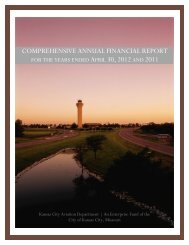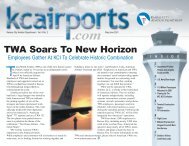Advance Terminal Planning Study Program Criteria Document
Advance Terminal Planning Study Program Criteria Document
Advance Terminal Planning Study Program Criteria Document
You also want an ePaper? Increase the reach of your titles
YUMPU automatically turns print PDFs into web optimized ePapers that Google loves.
KANSAS CITY NEW TERMINAL STUDY<br />
ADVANCE TERMINAL PLANNING STUDY<br />
PROGRAM CRITERIA DOCUMENT<br />
DRAFT<br />
3.2.3 TERMINAL AREA REQUIREMENTS<br />
The overall passenger enplanements were forecasted to grow at an annual average<br />
rate of 1.9 percent per year from approximately 5.1 million enplanements in 2011<br />
to 7.2 million enplanements in 2030. Peak hour enplanements are forecasted to<br />
grow from 1,900 passengers in 2011 to 2,900 passengers by 2030.<br />
As mentioned in Section 2.2.2, Current Conditions, of the 62 available gates<br />
(66 positions) KCI is currently operating from 30 gates as of 2012 and is forecasted<br />
to grow to 41 gates by 2030. Widebody aircraft are not predicted to operate<br />
commercial passenger service over the forecast period with limited B757<br />
operations, less than one percent, in 2030. However, one gate is held throughout<br />
the planning horizon for future operating flexibility.<br />
The narrowbody aircraft was used as the design aircraft and is expected to account<br />
for the predominant share of passenger operations maintaining 56 percent in 2012<br />
and 58 percent by 2030. Regional jets are expected to continue to account for a<br />
steady share of the passenger operations decreasing slightly from 44 percent in<br />
2011 to 42 percent by 2030. Large regional jets such as the 100-seat Embraer are<br />
assumed to potentially replace, or offer incremental capacity for the current aging<br />
100-seat aircraft such as the B717 and DC9 fleets.<br />
3.2.3.1 Airline Space<br />
The need for airline service represents a major portion of the passenger processing<br />
functions of a terminal. It contains all the exclusive areas typically required and<br />
leased by the airline tenants to support their operations. These functions include<br />
ticketing, baggage claim, airline operations and support, and departure lounges<br />
(holdrooms).<br />
DRAFT<br />
Airport tenant interviews were held with various station managers during the 2008<br />
Master Plan. These discussions along with on-site observations during this <strong>Study</strong><br />
were used to determine the adequacy of the various airline functions for conceptual<br />
planning purposes. It is anticipated that as the New <strong>Terminal</strong> concept moves into<br />
the subsequent architectural design/development phase, each individual airline will<br />
be consulted relative to their individual operational requirements. The airline<br />
requirements for the New <strong>Terminal</strong> that represent a conceptual baseline for<br />
planning purposes are discussed in the following paragraphs.<br />
Domestic/International Airline Space<br />
Airline Ticket Counters refers to the area occupied by the ticket counter, ticket<br />
agents, and the ticket counter baggage belt. It is typically assumed as an exclusive<br />
use operation for most U.S. airlines. This airline function is based on the peak hour<br />
origin and destination (O&D) enplaning (departing) passengers, their associated<br />
early arrival profiles, acceptable service times associated with the check-in process,<br />
and the percentage of the originating passengers that actually check-in at the<br />
terminal versus going directly to the gate or checking in at any offsite location.<br />
Industry accepted planning factors were used in this baseline analysis.<br />
Landrum & Brown Page 45<br />
April 2013







